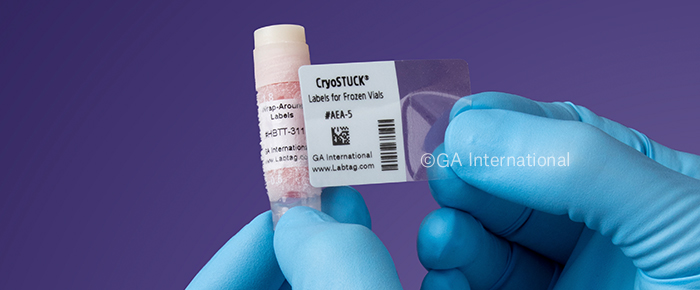
Labeling in the lab is important to ensure your samples, specimens, reagents, and buffers are all accurately identified. However, the information on these labels can become outdated or may be found to be incorrect, requiring containers to be re-labeled. Several options are available for re-labeling, depending on the container and environmental conditions it is expected to face.
What may need to be re-labeled in the lab
The most common items in the label that might need re-labeling are containers that have a label with incorrect or incomplete information. There are several ways this can happen. The label could have been handwritten illegibly due to poor penmanship or smearing of the ink; new information may have been discovered that needs to be added to the label; incorrect data may have been printed on the label, and a cover-up label with the correct information needs to replace it. There is also the possibility no identifier was used to start with, requiring a label to be added after the fact. Depending on the exact situation, the particular re-labeling solution used may vary. Below is an overview of the various re-labeling options available and when to use each one.
Re-labeling options
There are commonly two types of re-labeling options: blackout (also called block-out or cover-up) labels to conceal the existing information or clear labels to over-label and add new data.
Blackout labels
Blackout labels are specifically designed to conceal any already existing information or label. They have a unique opaque design that completely obscures the label and blocks out the info underneath. Typically provided with a permanent adhesive, these labels are a great way to cover up previously printed information, including pre-existing text, serialized numbers, and barcodes on your containers or samples, while also providing new data when necessary.
Blackout labels are available in various formats depending on the environmental conditions they will be exposed to. This includes cryogenic labels for cryo storage in liquid nitrogen (-196°C) and ultra-low temperature freezers (-80°C), chemical and solvent-resistant labels for containers that will endure chemical exposure, and autoclave-resistant blackout labels for material that will undergo sterilization. Blackout autoclave labels are also ideal for sterilizing bags and containers marked with sensitive or confidential information that must be autoclaved prior to disposal, such as biohazard and radioactive material.
Frozen containers
Cryo tubes, vials, and boxes that are stored under cryogenic conditions and need to be re-labeled pose an additional challenge. These frozen containers may need to be labeled while still frozen, as thawing them would potentially compromise their content’s integrity. As such, it is recommended that labeling occur on dry ice to maintain the temperature of the sample at -80°C, thus eliminating unnecessary freeze-thaw cycles. This requires blackout labels for frozen surfaces that will adhere to frozen containers freshly removed from liquid nitrogen or freezers, even in the presence of frost and moisture, while also completely obscuring the existing labels and obsolete information underneath. The re-labeled vials can then be stored back in liquid nitrogen or ultra-low temperature freezers, with no cure time required. In addition to blackout labels for frozen surfaces, clear labels are also available that will adhere to already frozen containers for over-labeling.
2D-barcoded tubes
2-D barcoded tubes are used by biorepositories, biobanks, and other facilities that house large inventories of samples. They work with automated liquid handlers and a fixed barcode scanner that uses the 2D barcode on the bottom of the vial to track the sample during storage and retrieval. Due to their unique shape, they require a specific type of label when re-labeling. Ideally, the label should identify the side and bottom of slim profile 2D automated sample storage and retrieval tubes. In addition, this added label should not interfere with the proper functioning of the automatic/robotic liquid handling system and needs to be compatible with the automated sample readers/scanners being used as well as the lab’s laboratory inventory management software (LIMS). 2D-barcoded tube labels offer the user maximum control over the encoded information when sampling or aliquoting specimen libraries, allowing the receiving vials to be labeled with identical or custom data. They allow the side of the tube to be printed with 1D barcodes, variable data, and human-readable text using most common thermal-transfer barcode printers, in addition to the 2D barcode printed on the bottom of the tube.
Over-labeling
Applying clear labels or laminate over an existing label can serve two purposes. First, the clear laminate acts as an extra layer of protection that shields the information from various environmental conditions, including extreme temperatures, exposure to harsh chemicals, and abrasion or mechanical damage. A clear label can be applied to a cryo vial to add protection against spraying with alcohol or used in a heavy-use area to guard against scratching and abrasion. A transparent label can also add additional information without concealing the existing label and its printout. The current label will remain legible and scannable, with the extra data or barcode simply displayed to the side.
No matter your re-labeling needs, LabTAG offers unique identification solutions to address your specific requirements. This included a wide range of blackout and clear labels, designed to work in various environments and conditions, including cryogenic storage, autoclaving, and with harsh chemicals and solvents.
LabTAG by GA International is a leading manufacturer of high-performance specialty labels and a supplier of identification solutions used in research and medical labs as well as healthcare institutions.